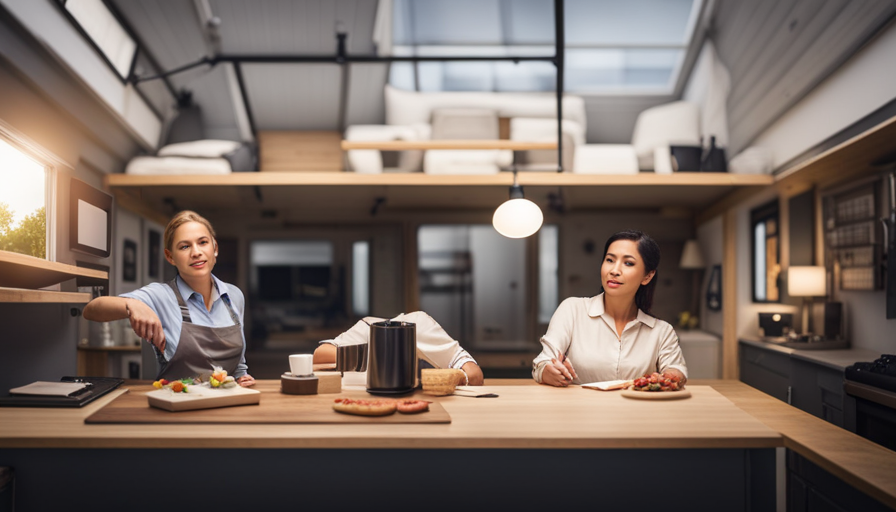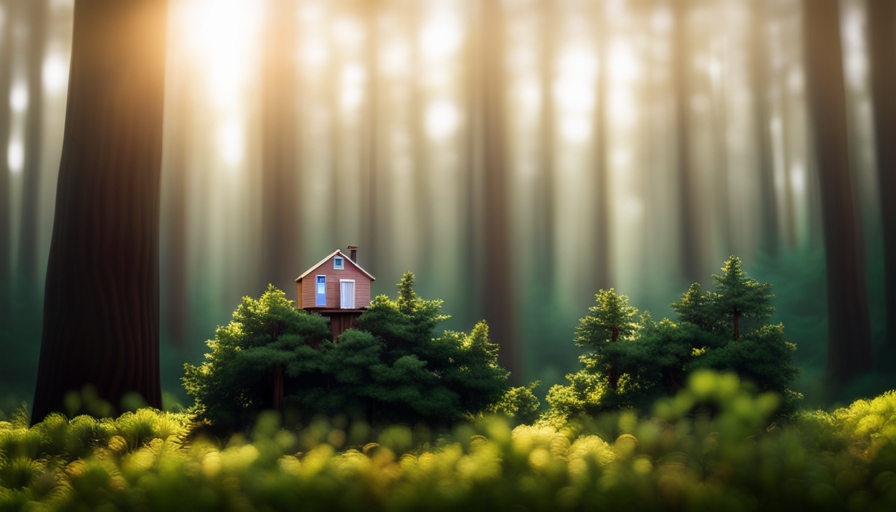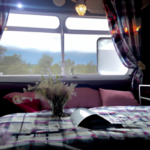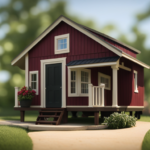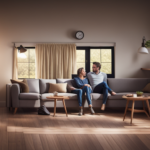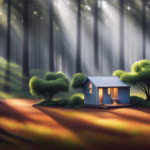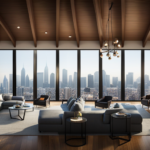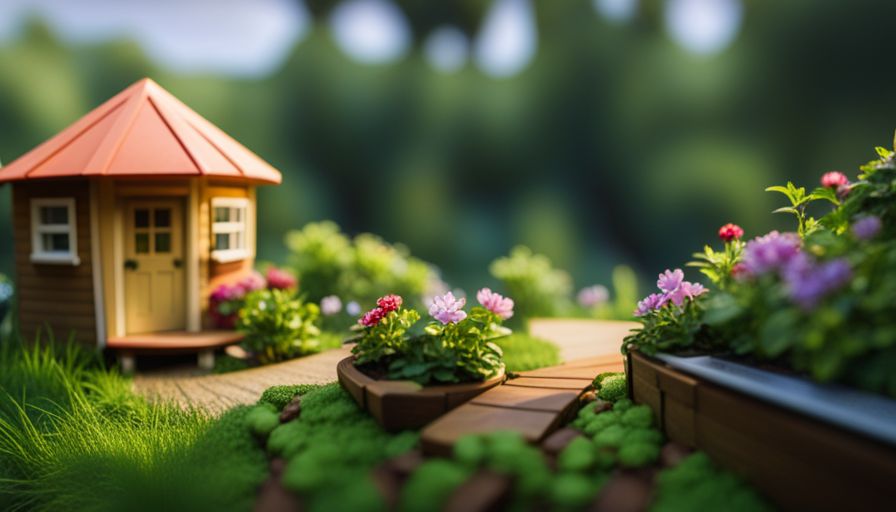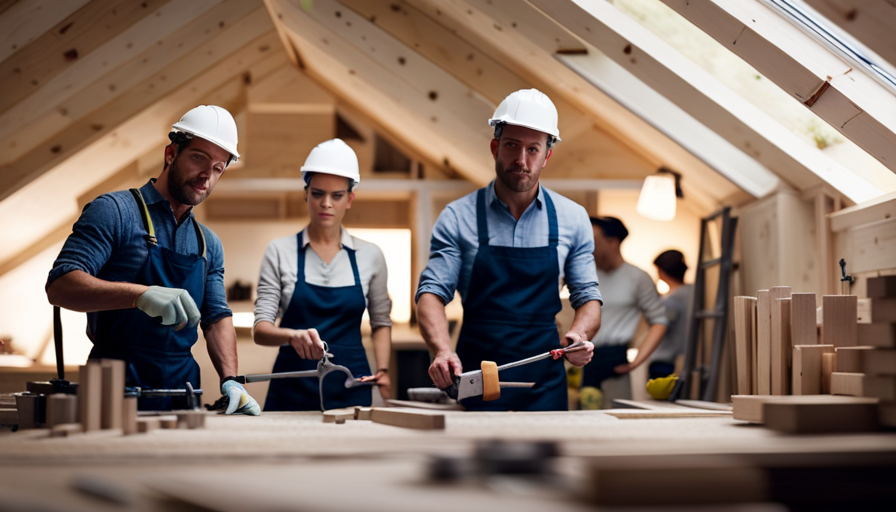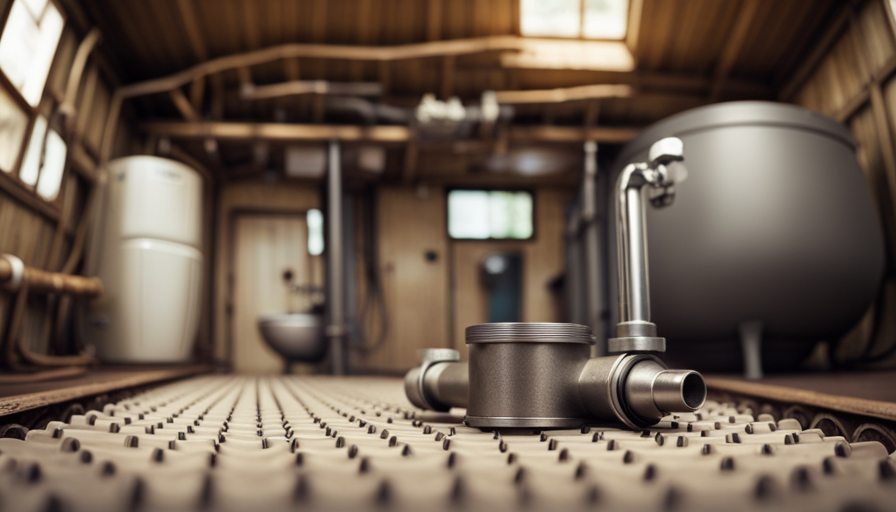Choosing to reside in a small dwelling might appear as a significant shift from conventional home concepts, yet this way of living has been increasingly popular lately. When I enter these snug homes, the contrast between their limited size and their effective use of space astonishes me. It’s impressive to see how these tiny buildings manage to offer all the amenities found in more spacious residences, fostering a life that is both minimalistic and eco-friendly.
In this article, I will delve into the inner workings of tiny house living and explore the various aspects that make it such an intriguing and viable alternative. From understanding the concept and benefits to choosing the right design and navigating legal considerations, we will uncover the secrets behind successful tiny house living.
So, let’s embark on this journey together and discover how these small dwellings are revolutionizing the way we think about home.
Key Takeaways
- Tiny house living promotes minimalism and sustainability, offering a simpler and more fulfilling life.
- Tiny houses are affordable, with lower construction and ongoing expenses, providing financial freedom.
- Mobility and flexibility are key benefits of tiny house living, allowing for easy exploration and new experiences.
- Smart design and utilization of space are crucial in tiny houses, maximizing functionality and comfort.
Understanding the Concept of Tiny Houses
So, you’re probably wondering how living in a tiny house actually works, right? Well, let me break it down for you.
The concept of tiny houses is part of a larger movement known as the tiny house movement. This movement advocates for alternative housing options that are smaller in size, typically less than 400 square feet. These houses are designed to maximize space efficiency and minimize environmental impact.
Living in a tiny house requires a shift in mindset and lifestyle. It’s about embracing simplicity and minimalism. Every square inch of space is carefully utilized, with creative storage solutions and multi-purpose furniture. It’s all about finding creative ways to make the most out of limited space.
One of the key benefits of tiny house living is affordability. Tiny houses are significantly cheaper than traditional homes, both in terms of construction costs and ongoing expenses. They require less energy to heat and cool, resulting in lower utility bills. Another advantage is the flexibility and mobility they offer. Tiny houses can be built on wheels, allowing owners to travel and explore different locations.
Tiny house living is a unique and innovative way of living that challenges traditional housing norms. It offers a simpler, more sustainable lifestyle that’s affordable and flexible.
In the next section, we’ll explore the benefits of tiny house living in more detail.
Benefits of Tiny House Living
When it comes to the benefits of tiny house living, three key points stand out: financial freedom and affordability, a minimalistic and sustainable lifestyle, and mobility and flexibility.
First and foremost, living in a tiny house allows me to achieve financial freedom by significantly reducing my living expenses. With a smaller mortgage or even no mortgage at all, I can allocate my money towards other important aspects of my life.
Additionally, the minimalistic and sustainable lifestyle that comes with living in a tiny house not only reduces my carbon footprint but also promotes a clutter-free and stress-free environment.
Lastly, the mobility and flexibility of a tiny house enable me to easily move and explore new places without the burden of traditional housing. Whether it’s a change in career, a desire for adventure, or simply a change of scenery, my tiny home can go wherever I go.
Financial Freedom and Affordability
To achieve financial freedom and affordability, living in a tiny house allows you to cut costs and live a more fulfilling life. With careful financial planning and consideration of alternative housing options, tiny house living offers a practical solution to escape the burden of a traditional mortgage and high living expenses.
The reduced size of a tiny house means lower construction and maintenance costs, as well as decreased energy consumption and utility bills. Moreover, the affordability of tiny houses allows individuals to allocate their resources towards experiences, travel, and personal growth rather than being tied down to excessive material possessions.
By embracing a minimalistic and sustainable lifestyle, tiny house living promotes a sense of freedom and contentment, enabling individuals to focus on what truly matters in life without feeling overwhelmed by financial stress.
Minimalistic and Sustainable Lifestyle
By embracing a minimalistic and sustainable lifestyle, you can simplify your life and reduce your environmental impact while living in a tiny house.
One of the key aspects of this lifestyle is adopting a minimalistic design, which focuses on simplicity and functionality. With limited space, every item in a tiny house has a purpose and serves multiple functions. This mindset encourages you to declutter and prioritize what truly matters to you.
Additionally, making eco-friendly choices is an integral part of the minimalistic and sustainable lifestyle. From using renewable energy sources like solar panels to using low-flow water fixtures, every decision you make can have a positive impact on the environment. By incorporating these principles into your life, you can create a harmonious and balanced living space within your tiny house.
Transitioning into the next section about mobility and flexibility, let’s explore the advantages of tiny house living on the go.
Mobility and Flexibility
Embracing a minimalist and sustainable lifestyle opens up exciting possibilities for those seeking a mobile and flexible living experience. Living in a tiny house allows for easy mobility, as these compact homes can be transported to different locations. However, mobility does come with its challenges. It requires careful planning and consideration of transportation logistics, such as finding appropriate routes, ensuring legal compliance, and securing permits.
Despite these challenges, the benefits of adaptability are well worth it. A tiny house allows individuals to explore different environments, experience new communities, and live a life of freedom and adventure. From mountains to beaches, city to countryside, the possibilities for exploration are endless.
Choosing the right tiny house design is crucial in ensuring optimal mobility and flexibility. It’s important to consider factors such as weight, size, and ease of assembly, as these will determine the ease of transportation and adaptability to various locations.
Transitioning into the next section, let’s delve into the key considerations when selecting the perfect tiny house design for your mobile lifestyle.
Choosing the Right Tiny House Design
When it comes to choosing the right tiny house design, there are two key points to consider: custom-built vs. pre-fabricated options and maximizing space with smart design.
Custom-built houses offer the advantage of being tailored to your specific needs and preferences, allowing for a more personalized living space. On the other hand, pre-fabricated houses provide a quicker and more cost-effective solution, as they’re mass-produced and can be easily assembled on-site.
Regardless of the approach, maximizing space with smart design is crucial in a tiny house, as every square inch counts. This can be achieved through clever storage solutions, multi-functional furniture, and creative layout arrangements.
Custom-built vs. Pre-fabricated
Opting for a custom-built tiny house allows homeowners to personalize every aspect of their living space, while choosing a pre-fabricated one offers the convenience of a quicker and easier setup process.
When comparing the cost of custom built vs. pre-fabricated tiny houses, it’s important to consider both the initial investment and long-term maintenance expenses.
Custom-built tiny houses tend to be more expensive upfront due to the customization options and higher quality materials. However, they often have lower maintenance costs in the long run.
On the other hand, pre-fabricated tiny houses are generally more affordable initially, but may require more maintenance and repairs over time.
Additionally, custom-built tiny houses offer the freedom to design a space that perfectly suits individual needs and preferences. With smart design choices, homeowners can maximize space and create a functional and comfortable living environment.
Transitioning into the next section, maximizing space with smart design is crucial for optimizing tiny house living.
Maximizing Space with Smart Design
When it comes to tiny house living, one of the biggest challenges is making the most of limited space. That’s why maximizing storage and utilizing innovative furniture is crucial.
By incorporating smart design elements, you can create a functional and comfortable living space. One way to maximize storage is by utilizing vertical space. Installing tall shelves or using wall-mounted storage solutions can help you make the most of every inch.
Another option is to invest in multifunctional furniture, such as a bed with built-in storage drawers or a dining table that can be folded away when not in use. Additionally, you can consider incorporating hidden storage compartments into your tiny house. This could include under-bed storage, hidden cabinets, or even a staircase with built-in drawers. These clever storage solutions allow you to keep your space organized and clutter-free.
Transitioning to the next section, let’s explore the essential features and amenities that are commonly found in tiny houses.
Essential Features and Amenities in Tiny Houses
Living in a tiny house means having all the essential features and amenities in a compact space. These include a cozy sleeping loft, a functional kitchenette, and a cleverly designed multipurpose living area. These features are carefully chosen to maximize the available space and provide a comfortable living experience.
The sleeping loft is usually elevated to make use of vertical space, allowing for a separate sleeping area without sacrificing too much floor space. It often includes built-in storage options to keep belongings organized.
The kitchenette in a tiny house is designed to be efficient and functional. It typically includes a small refrigerator, a stovetop or cooktop, and a compact sink. Storage solutions such as pull-out drawers and overhead cabinets are utilized to maximize the available space. Additionally, multipurpose furniture and clever design elements are incorporated to create a versatile living area. For example, a dining table can double as a workspace or transform into a bed for guests.
While tiny houses may have limited square footage, they are not lacking in essential amenities. Many tiny houses include a bathroom with a shower, toilet, and sink. Some even have space-saving features like composting toilets or compact shower stalls. It’s important to remember that the design and amenities in a tiny house may vary depending on personal preferences and local regulations.
Moving on to legal and zoning considerations, it’s crucial to understand the regulations and restrictions in your area when it comes to tiny house living.
Legal and Zoning Considerations
Navigating the legal and zoning landscape can be a complex puzzle for those interested in the world of tiny house living. Understanding the legal considerations and zoning requirements is crucial to ensure a smooth and hassle-free experience. Here are four important factors to consider:
-
Local regulations: Different areas have different regulations regarding tiny houses. It’s important to research and understand the specific rules and requirements in your desired location. These may include minimum square footage requirements, setback requirements, and even restrictions on where tiny houses can be parked.
-
Building codes: Tiny houses must comply with building codes to ensure safety and quality. Familiarize yourself with the applicable building codes in your area and make sure that your tiny house meets or exceeds these standards.
-
Permits and inspections: Depending on local regulations, you may need to obtain permits and undergo inspections during the construction and placement of your tiny house. It’s essential to adhere to these requirements to avoid legal issues in the future.
-
Land ownership: If you plan to park your tiny house on someone else’s property, make sure to have a clear understanding of the legal implications and responsibilities involved. Consider lease agreements, easements, and any additional legal documentation that may be required.
Navigating the legal and zoning considerations is just the first step in the journey of tiny house living. Once you’ve successfully tackled these challenges, you can move on to the exciting part of downsizing and simplifying your life without compromising on comfort and functionality.
Downsizing and Simplifying Your Life
Downsizing and simplifying your life is the key to unlocking a world of freedom and flexibility in tiny house living. By reducing the amount of possessions and clutter, you can create a living space that is efficient and functional. Living arrangements in a tiny house require careful consideration and planning to make the most of the limited space available.
One of the benefits of downsizing is the ability to live a more minimalist lifestyle. With fewer belongings, there is less to clean, organize, and maintain. This frees up time and energy to focus on experiences and relationships rather than material possessions. Additionally, downsizing can lead to financial savings as there are fewer expenses associated with maintaining a smaller space.
To illustrate the benefits of downsizing, consider the following table:
| Downsizing Benefits | Explanation |
|---|---|
| More Freedom | Living with less allows for greater flexibility and the ability to travel or move more easily. |
| Lower Expenses | A smaller space means lower utility bills, property taxes, and maintenance costs. |
| Environmental Impact | Downsizing reduces the amount of resources and energy required to maintain a home. |
| Simplified Life | With fewer belongings, life becomes less complicated and more focused on what truly matters. |
By downsizing and simplifying, you can create a more intentional and fulfilling life in a tiny house. However, there are challenges that come with this lifestyle, which will be explored in the next section about overcoming these obstacles.
Overcoming Challenges of Tiny House Living
Overcoming the challenges of tiny house living requires a mindset shift towards embracing simplicity and prioritizing experiences over material possessions. Living in a tiny house often comes with its own set of obstacles, including social stigma and managing limited storage. However, with the right approach and a willingness to adapt, these challenges can be overcome.
-
Overcoming social stigma: Living in a tiny house can sometimes be met with skepticism or judgment from others who may not understand the appeal. However, by focusing on the benefits of minimalism, such as financial freedom and reduced environmental impact, it becomes easier to brush off any negativity and stay committed to your chosen lifestyle.
-
Managing limited storage: One of the most common challenges in tiny house living is finding creative ways to maximize storage space. This may involve utilizing multifunctional furniture, installing wall-mounted shelves and hooks, or adopting a minimalist approach to belongings. By prioritizing what is truly essential and finding innovative storage solutions, you can effectively manage limited space and keep your tiny house organized.
In order to successfully navigate the challenges of tiny house living, it is important to adopt a positive mindset and be open to finding creative solutions. By embracing simplicity and prioritizing experiences, you can overcome social stigma and effectively manage limited storage.
In the next section, we will explore some helpful tips for successful tiny house living.
Tips for Successful Tiny House Living
When it comes to successful tiny house living, organization and maintenance are key. Keeping a small space clutter-free and well-maintained is essential for maximizing efficiency and functionality.
Additionally, energy efficiency and conservation play a crucial role in tiny house living, as every square inch counts.
Finally, creating a sense of community is important in order to fully enjoy the benefits of tiny house living. It allows for shared resources, support, and a sense of belonging.
Organization and Maintenance
Organization and maintenance in tiny house living can be challenging, but it’s worth noting that studies have shown that tiny house owners spend an average of only 10-15 minutes per day on cleaning and tidying up their compact living spaces. To effectively organize your tiny house, consider these tips:
-
Utilize vertical space: Install shelves, hooks, and hanging organizers to maximize storage and keep things off the floor.
-
Multi-functional furniture: Opt for furniture pieces that serve multiple purposes, such as a sofa with built-in storage or a bed that can be folded into a desk.
-
Declutter regularly: With limited space, it’s essential to regularly declutter and get rid of items you no longer need.
As for maintenance, here are a few strategies:
-
Create a cleaning schedule: Establish a routine for cleaning tasks to ensure everything stays neat and tidy.
-
Minimize moisture: Proper ventilation and regular maintenance of plumbing and insulation can help prevent moisture-related issues.
-
Regularly inspect and repair: Keep an eye out for any damages or maintenance needs to address them promptly.
With effective organization and maintenance strategies, tiny house living can be both comfortable and efficient. Speaking of efficiency, let’s now explore energy efficiency and conservation in tiny houses.
Energy Efficiency and Conservation
By implementing energy-saving practices and utilizing sustainable technologies, I’ve been able to create a cozy and eco-friendly living space in my tiny house. Energy efficiency is a top priority. I’ve made several changes to reduce my energy consumption. I’ve installed energy-efficient appliances and LED lighting throughout my home. I also make sure to seal any air leaks and insulate my walls and windows properly.
To further reduce my reliance on traditional energy sources, I’ve incorporated renewable energy systems such as solar panels and wind turbines. These systems provide me with clean and renewable power, reducing my carbon footprint. By focusing on energy efficiency and embracing renewable energy, I’ve created a sustainable and environmentally friendly lifestyle in my tiny house.
Transitioning into the next section, I’ll now discuss how I’ve been able to create a sense of community in this unique living arrangement.
Creating a Sense of Community
To truly embrace the sense of community in your sustainable living space, it’s important to connect with your neighbors and share resources. This can include carpooling or starting a community garden, which studies have shown can increase overall happiness and well-being.
Community building is a key aspect of tiny house living. It allows for social interactions and creates a supportive network of like-minded individuals. Living in close proximity to your neighbors fosters a sense of belonging and encourages collaboration.
It’s not uncommon for tiny house communities to organize regular gatherings, such as potluck dinners or movie nights. These events bring residents together and strengthen their bonds. These interactions not only enhance the quality of life but also provide opportunities for learning and personal growth.
By engaging in community activities, residents can gain inspiration from real-life stories and experiences. This can further fuel their passion for sustainable living.
Real-Life Stories and Inspirations
Living in a tiny house can be a truly transformative experience, as it allows individuals to hear the inspiring stories of real people who have embraced minimalism and found true happiness. These real-life stories serve as a testament to the power of tiny house living, showing that it’s not just a trend, but a lifestyle choice that can have a profound impact on one’s well-being.
One of the most fascinating aspects of these stories is the real-life challenges that individuals face when transitioning to tiny house living. From downsizing their possessions to adjusting to a smaller living space, these challenges push people to reevaluate their priorities and find creative solutions. It’s inspiring to see how people overcome these obstacles and find fulfillment in simplicity.
In addition to the challenges, real-life stories also showcase unique design ideas that maximize the functionality and comfort of tiny houses. From ingenious storage solutions to innovative space-saving techniques, these designs demonstrate the endless possibilities of tiny house living. They prove that living in a small space doesn’t mean sacrificing style or convenience.
As we explore the future of tiny house living, these real-life stories and inspirations serve as a reminder of the potential that lies ahead. They show us that the movement towards minimalism isn’t just a passing fad, but a way of life that can bring joy, fulfillment, and a stronger sense of community.
Exploring the Future of Tiny House Living
The future of tiny homes looks promising, with an estimated 63% increase in the number of people choosing to embrace this minimalist lifestyle by 2025. As the demand for tiny houses continues to rise, it is expected that future innovations and technological advancements will play a significant role in shaping the way we live in these small spaces.
One area of future innovation in tiny house living is the integration of smart home technology. With the advancements in Internet of Things (IoT), homeowners will be able to control various aspects of their tiny homes through their smartphones or other connected devices. This includes managing the temperature, lighting, security systems, and even appliances, all with the touch of a button.
Another exciting development is the exploration of eco-friendly and sustainable solutions for tiny homes. As more people become conscious of their environmental footprint, future tiny houses may incorporate renewable energy sources like solar panels, rainwater harvesting systems, and composting toilets. These innovations will allow homeowners to live off-the-grid and reduce their reliance on traditional utilities.
Additionally, future tiny homes may feature modular designs that allow for easy customization and expansion. This would enable homeowners to adapt their living spaces as their needs change over time. Whether it’s adding an extra room, a workspace, or even a garden, modular designs would provide the flexibility and versatility required for a sustainable and comfortable lifestyle.
The future of tiny house living is full of exciting possibilities. With advancements in technology and a growing interest in sustainable living, we can expect to see innovative solutions that make tiny homes even more efficient, comfortable, and environmentally friendly.
Frequently Asked Questions
How much does it cost to build a tiny house?
Building a tiny house can vary in cost depending on factors such as size, location, and the materials used. A cost estimation for a basic tiny house can range from $10,000 to $30,000. However, this estimate doesn’t include the cost of land, permits, or utilities.
Construction materials for tiny houses typically include lumber, insulation, roofing, and siding. It’s important to research and plan carefully to ensure an accurate cost estimation and to find affordable yet durable materials for your tiny house project.
Can I legally live in a tiny house on any piece of land?
Yes, it’s not always legally permitted to live in a tiny house on any piece of land. Legal restrictions and zoning regulations vary by location, and they dictate where and how tiny houses can be placed. Some areas may require a minimum square footage for dwellings or specific permits for tiny house living. It’s essential to research local regulations and obtain the necessary permits to ensure compliance with the law when considering living in a tiny house.
What are the most common challenges people face when transitioning to tiny house living?
Transitioning to tiny house living can be like navigating through a maze of challenges. It requires a careful dance of space management. The most common hurdles include adjusting to the lack of storage, finding creative solutions for everyday tasks, and adapting to a minimalist lifestyle. But with determination and resourcefulness, these challenges can be overcome, unveiling a world of simplicity and freedom.
Are there any restrictions on the size or design of a tiny house?
There are indeed restrictions on the size and design of a tiny house. Zoning regulations play a crucial role in determining where tiny houses can be placed. Some areas allow tiny houses only as accessory dwelling units on existing properties, while others have specific zones dedicated to tiny houses.
Building codes also dictate certain requirements for tiny house design, such as minimum ceiling heights, stair regulations, and safety measures. It’s important to research and comply with these regulations before embarking on a tiny house project.
How do tiny house owners handle utilities, such as water and electricity?
Ah, the joys of tiny house living. It’s truly remarkable how we tiny house owners handle utilities like water and electricity. We simply wave our magic wands and poof! The resources appear. Just kidding.
In reality, we are masters of managing our resources. Through careful planning and clever systems, we ensure a self-sustainable off-grid living experience. We collect rainwater for our water needs and harness solar power for electricity. It’s an art, really.
Conclusion
Well, who would’ve thought that living in a tiny house could be so fulfilling? It may seem counterintuitive, but the simplicity and minimalism of tiny house living can actually lead to a more meaningful and satisfying life.
From saving money to reducing environmental impact, the benefits are undeniable. And despite the challenges and limitations, people have found creative ways to overcome them and truly thrive in their tiny homes.
So, if you’re looking for a unique and sustainable way of living, the future of tiny house living is definitely worth exploring.
Hi, I’m Emma. I’m the Editor in Chief of Tiny House 43, a blog all about tiny houses. While tree houses are often associated with childhood, they can be the perfect adult retreat. They offer a cozy space to relax and unwind, surrounded by nature. And since they’re typically built on stilts or raised platforms, they offer stunning views that traditional homes simply can’t match. If you’re looking for a unique and romantic getaway, a tree house tiny house might just be the perfect option.
